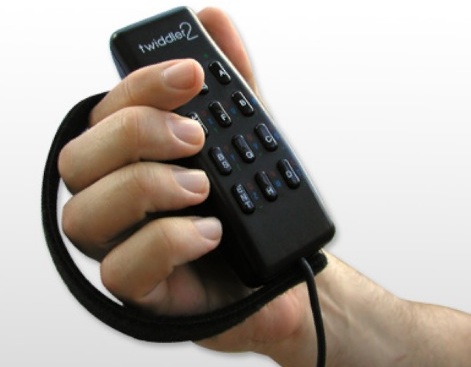Difference between revisions of "Chorded Keyboard"
Caseorganic (Talk | contribs) |
Caseorganic (Talk | contribs) |
||
| Line 16: | Line 16: | ||
[[Category:Concepts]] | [[Category:Concepts]] | ||
| + | [[Category:Book Pages]] | ||
| + | [[Category:Finished]] | ||
__NOTOC__ | __NOTOC__ | ||
Revision as of 20:16, 25 September 2011
Definition
Unlike the Persistent Architecture of the standard-issue desktop keyboard, a chorded keyboard is an input device that allows a user to type in a chordal pattern. The advantages of chordal keyboards are that they allow their users to type with one hand, or while moving around. The Twiddler chorded keyboard is perhaps the most popular chorded keyboard in existence. It has been used by Steve Mann, Thad Starner and their respective students. Some students at MIT and Carnegie Mellon University have used the Twiddler as the primary input device for class notes, everyday writing such as E-mail and even entire dissertations. Thad Starner and others produced a research study on the various rates of one handed mobile input with the Twiddler and reported that some test subjects could acheive speeds of up to 60 wpm on the devices.[1]. Steve Mann is known to use the Twiddler to edit Wikipedia entries while waiting to cross the street in Toronto, Ontario.[2]
"Twiddler was one of the first components I bought when designing my wearable computer. After six years of everyday use, I wouldn't think of using a wearable without one. The convenience and ergonomic benefits become apparent with long-term use. In fact, for the last two years, the Twiddler and my wearable computer have replaced my desktop (e.g. my PhD thesis was written with the Twiddler).
When starting the MIT Wearable Computing Project, Georgia Tech and former MIT Media Lab professor Thad Starner issued every member a Twiddler as their primary text input device.[3] More generally, new users can learn the alphabet in 5 minutes and can be touch typing in an hour. Though it takes time for the fingers to "loosen up" to accomodate the new motion (much like learning to play an instrument or learning how to type on a desktop), many new users are up to 10 words a minute with a weekend's worth of practice, and current non-touch typists remark that it is easier than learning the desktop QWERTY keyboard".[4]
Related Reading
References
- ↑ An Empirical Study of Typing Rates on mini-QWERTY Keyboards]] (CHI. Portland, OR. April 2005
- ↑ Steve Mann's Wikipedia User Profile http://en.wikipedia.org/wiki/User:Glogger
- ↑ Mobile Entry - Contextual Computing Group - College of Computing - Georgia Institute of Technology http://www.cc.gatech.edu/~thad/030_research.htm
- ↑ Thad Starner, Professor at Georgia Tech and former MIT Media Lab. Testimonial on http://www.handykey.com/testimonials.html Accessed 15 April 2011.
